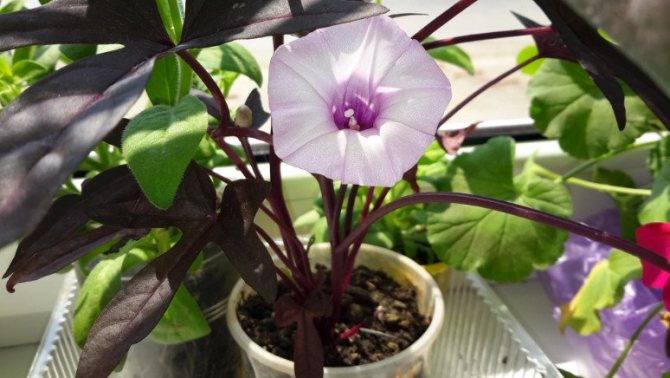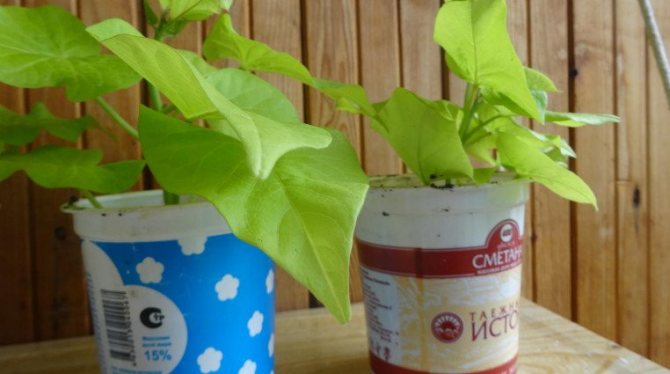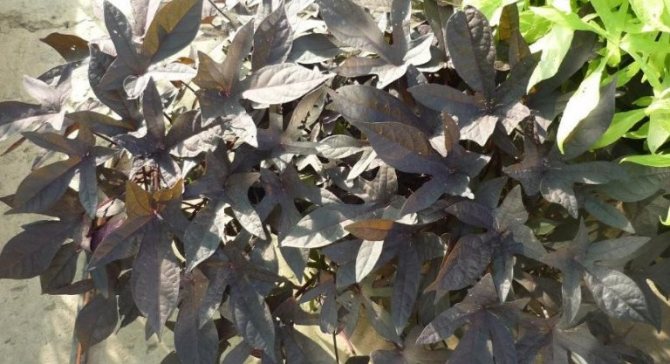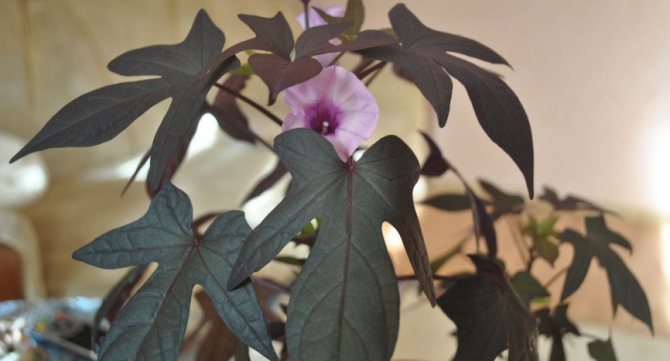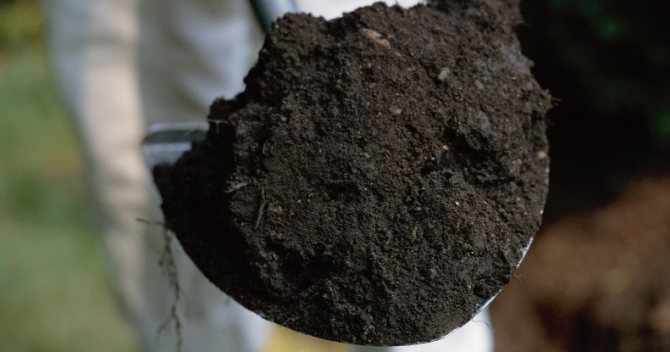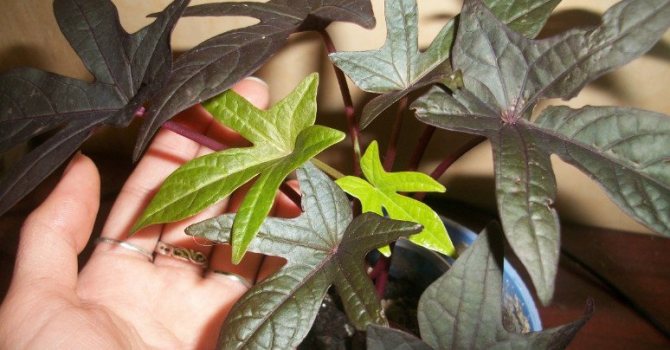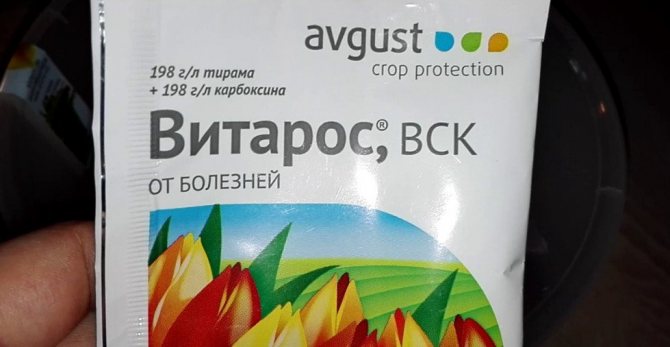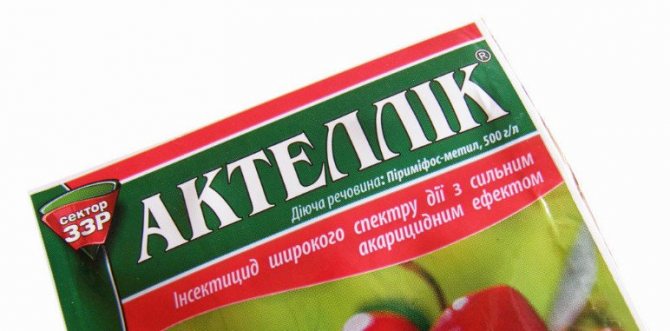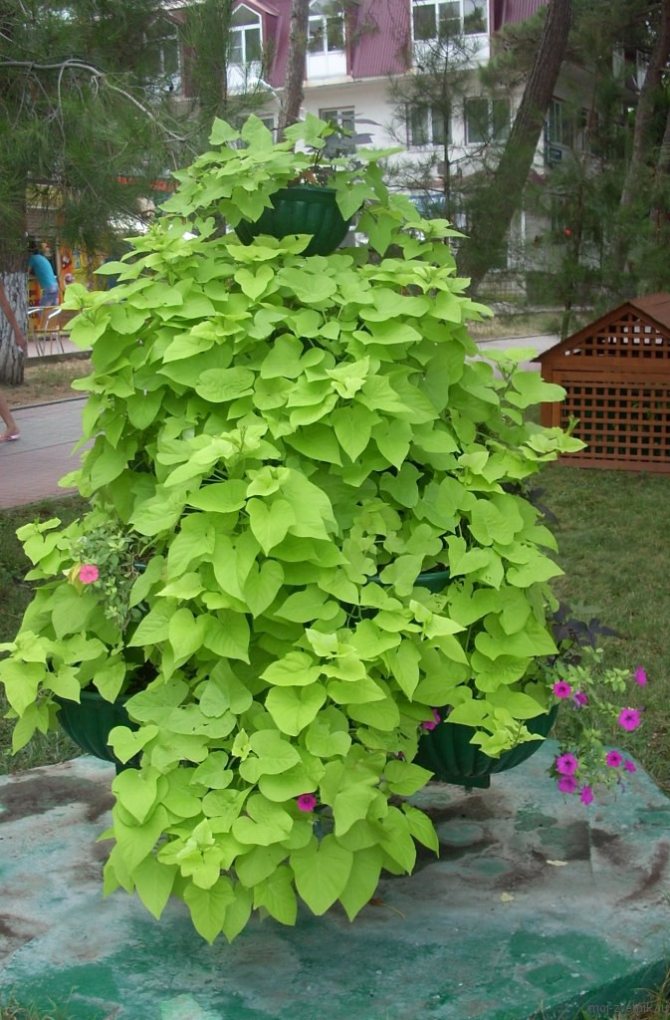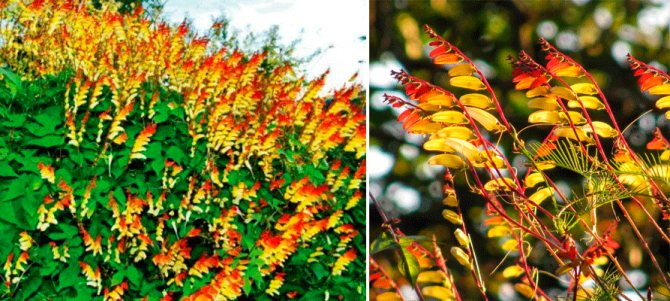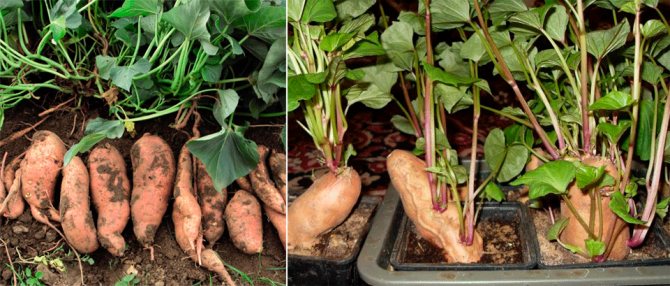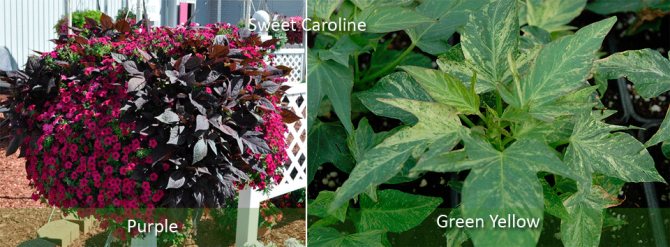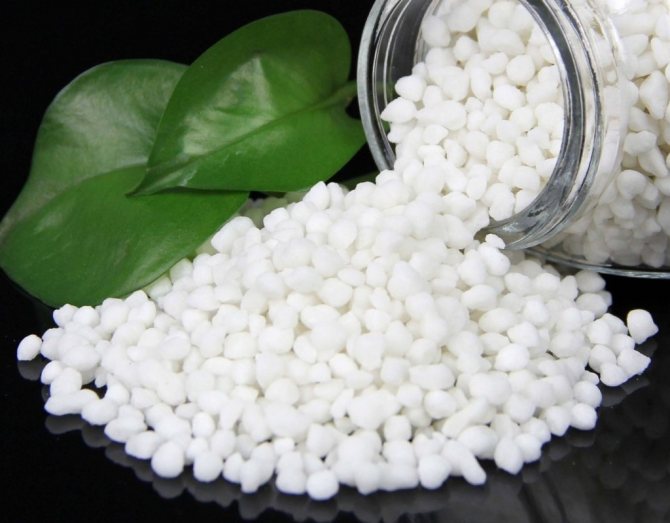Morning glory sweet potato (Ipomoea batatas), or sweet potato sweet potato is a valuable food and forage crop, which belongs to the type of tuberous plants of the genus Ipomoea of the Bindweed family. The homeland of such a culture is Peru and Colombia, and from there it spread throughout South America even before the Europeans arrived there. Then the sweet potato was brought to South and East Polynesia, to Easter Island, to the West Indies and New Zealand. The edible roots of such a plant were called "kamotli" by the Aztecs; they ate them boiled, fried and raw. It was brought to the Philippine Islands by the Spaniards during the Conquest, and from there the sweet potato came to Taiwan, the Mediterranean and Japan. Today, such a plant is not found in the wild, but it is widely cultivated in various countries. It is grown in tropical and subtropical regions, and even in warm areas of the temperate zone, for example, sweet potatoes have been cultivated for a long time in Ukraine, while in the Moscow region it is found quite often. In the industrial cultivation of sweet potatoes, the leading places are occupied by such countries as: Indonesia, China and India.
Brief description of cultivation

- Landing... For seedlings, seeds are sown in the last days of January or in the first days of February, seedlings are planted in open soil from mid to late May.
- Illumination... Needs bright sunlight.
- Priming... Loamy or sandy loam soil, which contains a large amount of nitrogen, is excellent.
- Watering... After transplanting seedlings into open ground, for the first 4 weeks, it is watered regularly and abundantly, and starting from the middle of the summer period, watering is carried out 1 time per decade, but if it rains systematically, then the plant will have enough natural precipitation. The last time the bushes need to be watered 15–20 days before harvest.
- Fertilizer... Top dressing is carried out during the formation of tubers (approximately in mid-August), the plant needs potassium, for this, a solution of wood ash should be added to the soil, for its preparation it is necessary to combine 1 bucket of water and 1-2 tbsp. ash, the mixture should be infused for 7 days, while it must be systematically stirred. To feed 1 bush, 1 liter of the mixture is poured under it.
- Reproduction... As a rule, tubers or parts thereof.
- Harmful insects... Khrushchev (May beetle larvae), slugs, spider mites and wireworms.
- Diseases... Blackleg.
- Properties... It has a high nutritional value, is considered a dietary product and has medicinal properties.
Vegetable treatment
Sweet potato is used in folk medicine for treatment and prevention.:
- heart disease, atherosclerosis, high blood pressure;
- to increase immunity and as a general tonic;
- with diseases of the gallbladder and kidneys;
- effectively used for exacerbation of gastritis and peptic ulcer disease;
- as a prophylaxis of oncological diseases;
- with intolerance to fiber (beets, carrots), sweet potatoes are also eaten;
- tubers are useful for insomnia, depression and neurosis (potassium in the composition exhibits antidepressant properties).
Features of sweet potato


Sweet potato is a herbaceous vine. The length of its creeping stems-lashes reaches about 500 cm, they are able to quickly take root in the nodes. The height of the bush varies from 15 to 18 meters.The lateral roots are very thickened, they form tubers, the flesh of which is edible, it can be colored orange, cream, red, yellow, white, pink or purple. The mass of tubers varies from 0.2 to 3 kilograms or more. Long-petiolate leaf plates have a heart-shaped or palmate-lobed shape. Axillary funnel-shaped flowers have a large corolla, which is painted in white, pink or light lilac. But for most varieties, when grown in the middle lane, flowering does not occur. The fruit is a box in which there are 4 seeds of black or brown color, reaching 0.35-0.45 cm in diameter.
Popular varieties
The decorative value of the morning glory is not only brought about by the blooming appearance. Many varieties do not have a lush color, but are especially valued for foliage, decorative forms and colors. The most popular and demanded among flower growers are the following varieties:
- Margarita - characterized by a heart-shaped leaves of a rich golden-salad color;
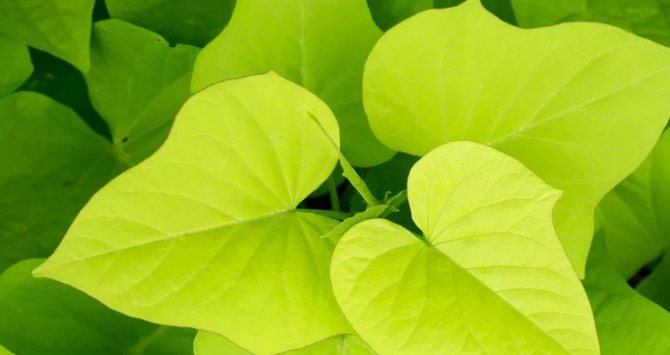

- Blackie - varietal features are five-lobed, deeply dissected leaves of a dark purple color and a light purple color of flowers;


- Sweet heart red - the peculiarities of the variety are young leaves of a light lettuce color, eventually acquiring a green-purple color;


- Pink frost - characterized by solid leaves of a triangular shape, the color of the leaves is green with a pink frame and white stripes;
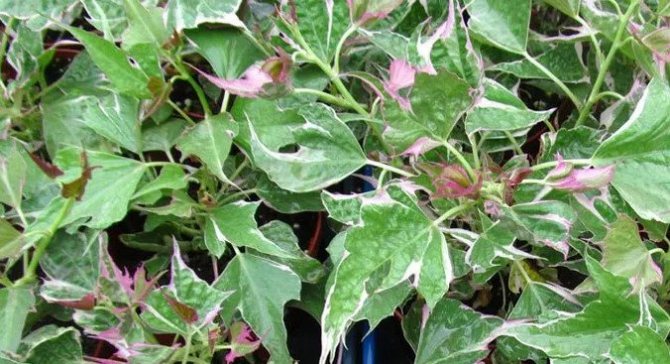

- Illusion emerald lace - has narrow lanceolate five-lobed leaves of light salad color.
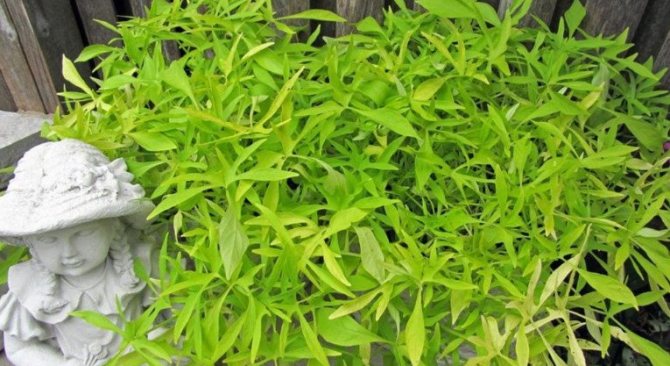

All presented varieties are liana-shaped, have a large and lush growth and are perfect for ampel cultivation. Contrasting varieties look especially impressive in the neighborhood.
Growing sweet potatoes from seeds


Sowing
For the propagation of sweet potatoes when grown in middle latitudes, the method of sprouting tubers is used, because under these conditions flowering occurs infrequently, as a result of which the formation of seeds does not occur. Of course, you can buy seeds in a specialized store, and since this plant is thermophilic, and its growing season lasts 90-180 days, you need to sow sweet potatoes for seedlings, and not in open soil. The seed material of such a plant has a very high germination capacity.
Sowing for seedlings is carried out in the last days of January or the first - in February. The seeds need pre-sowing preparation, for this they must be immersed in lukewarm water for 24 hours, then they must be disinfected in a solution of copper sulfate or manganese potassium. The processed seed needs to be dried. A soil mixture suitable for sowing should be loose and nutritious, for example, you can use a substrate consisting of turf, humus or sand (1: 1: 1). For sowing sweet potatoes for seedlings, you cannot take garden soil, because it does not contain a very large amount of nutrients, and it may also contain pathogenic microorganisms or pest eggs. The soil mixture needs disinfection, for this it is heated in the microwave or ignited in the oven. Sowing seeds is carried out in a moistened soil mixture, while they must be buried by 15–20 mm, then its surface is slightly tamped and watered. The container must be covered with glass or film, then it is placed in a well-ventilated and well-lit place before the first seedlings appear, while the air temperature should be from 18 to 20 degrees.
Seedling growing rules
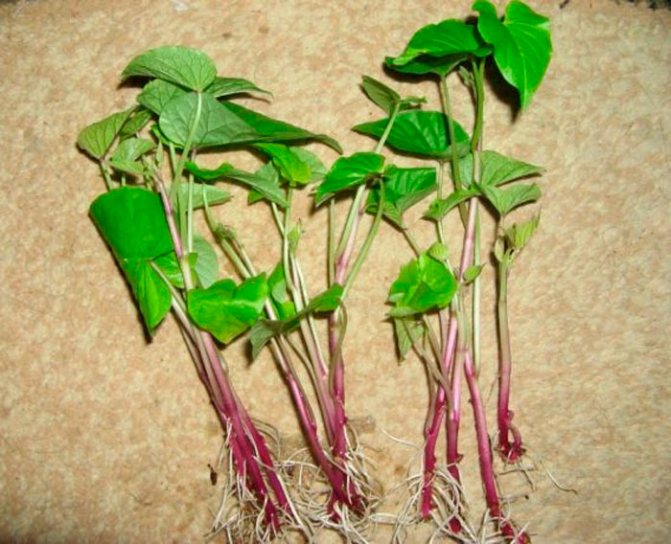

In order to grow such seedlings, it will need a certain temperature regime - from 20 to 30 degrees. Watering should be moderate, but systematic. Although this plant is moisture-loving, it reacts extremely negatively to stagnant water in the root system. For irrigation, water at room temperature is used, which must settle for 24 hours. Watering is carried out only after the top layer of the soil mixture dries out.The room where the seedlings are located should be systematically ventilated, but the plant must be protected from a draft. It is recommended to air the sweet potato immediately after it is watered. After the height of the seedlings is 15 centimeters, and they have 4-5 internodes, experts advise to start hardening them, which will allow the plants to adapt to new conditions before you transplant them into open ground. To do this, the seedlings are transferred to the street for some time every day for 15 days. The duration of such a procedure must be increased gradually until it can be outdoors around the clock.
Landing
Planting time - late May, early June. The optimum temperature is 25-30 degrees. In the temperate zone, sweet potatoes are grown as an annual crop. For sowing, tubers with a length of 20-30 cm from the last harvest are mainly used, which are planted in seedling beds in greenhouse conditions, or in film beds.
Long cuttings grow from tubers in 5-6 weeksthat are cut and used for fresh planting.
Planting sweet potatoes in open ground


What time to plant
Sweet potato seedlings are transplanted into open soil only after the air temperature in the daytime is no longer below 20 degrees, while the ground should be warmed up to 15 degrees. For example, in Ukraine, especially in its southern part, seedlings are planted in open ground already in the last days of April, while in the Moscow region this procedure is often carried out in the first days of June.
An open area, well-lit by the sun and having reliable protection from strong gusts of wind, is perfect for growing such a crop. It grows best in loamy or sandy loam soil, which is characterized by low acidity, while it must contain a large amount of nitrogen. However, sweet potatoes can also be grown on other soils.
Site preparation
Site preparation should be done in the autumn. Digging the soil is carried out to a depth of 15 to 20 centimeters, while potassium sulfate, humus and superphosphate should be added to it. The acidic soil must be limed half a month before fertilizing. In the spring, immediately before planting, the seedlings on the site must be loosened, and ammonium nitrate should be added to it.
Rules for planting in open soil


The depth of the planting holes should be about 15 centimeters, while the distance between them is 0.4 m, and the distance between the rows is 0.7 m.When planting long-leaved varieties, the planting holes should be made according to the scheme 0.7x0.7 m, but if the sweet potato plant more compactly, then over time it will form a carpet of foliage and shoots, which can protect the surface of the garden from rapid evaporation of moisture. The plant must be buried in the soil in such a way that the pair of internodes located at the very bottom are underground. To make the seedlings easier to transplant and take root quickly, it is recommended to cut off all the foliage from the bushes, while leaving only 1-2 pairs of upper leaf plates. When the plant is planted in open soil, its surface should be tamped down and the bed should be well watered. Each bush should be covered with a cut plastic bottle, which should be transparent, or a glass jar. After the young foliage begins to grow in the plants, the shelter must be removed.
Use in landscape design
Morning glory sweet potato is a climbing plant, and therefore it is able to ennoble not only an ordinary apartment window or balcony, but also give a blooming look to a garden plot. Its feature is the ability to form dense curtains, it looks spectacular in landscape design as vertical gardening.This means planting a plant to decorate arches, gazebos, fences and other hedges. As a climbing plant, in the process of development, morning glory tightly wraps around the support, next to which it is planted, thus contributing to the decoration of the territory and helping to hide the existing flaws.


Varietal variety contributes to the creation of original compositions when combined, which contributes to the creation of a unique design of a garden plot or park area, and a long flowering pleases with a palette of colors throughout the summer-autumn season. As a climbing plant, morning glory also looks great when grown in hanging pots. Dense and lush vegetation falls beautifully, and when two contrasting varieties are combined, it looks more impressive. The ampel cultivation method is suitable for the conditions of a garden plot, apartment or balcony and is able to give comfort to even the most modest interior.
Sweet potato care
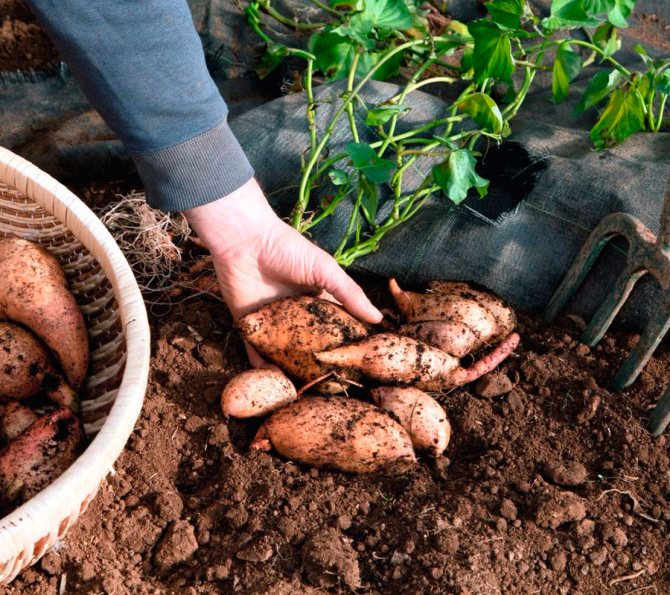

Both an experienced gardener and a beginner can grow a sweet potato on their site. Most importantly, one must remember that the planting or seed material must be of high quality, and the plants must be properly looked after and adhere to the agrotechnical rules of this culture. Also, do not forget that this plant is distinguished by its thermophilicity. There is nothing difficult in caring for sweet potatoes: if necessary, planting should be sheltered from the cold, water them in time, weed, feed them, protect them from harmful insects and diseases, and also loosen the surface of the beds.
When growing such a culture, it must be remembered that its lashes should in no case take root in internodes, in this regard, it is necessary to systematically raise each shoot in order for the resulting roots to break off. In order for the tubers to be larger, in the twenties of August, it is necessary to make a mandatory pinching of the upper part of each lash.
How to water
This plant is drought tolerant and therefore does not need to be watered abundantly. However, in the first 4 weeks after transplanting seedlings into open soil, watering should be systematic and abundant, after which it is reduced to moderate. From the middle of summer, the garden is watered no more than 1 time in 1.5 weeks, but if it rains regularly at this time, then natural precipitation will be enough for the bushes. When 15–20 days are left before harvesting, you must stop watering the sweet potato.
Top dressing of sweet potato


During the formation and growth of tubers, sweet potatoes are especially in need of feeding, for which potash fertilizer is used. Typically, this time falls in mid-August. An infusion of wood ash is excellent for feeding; in order to prepare it, you need to combine 1 bucket of water and 1-2 tbsp. wood ash, the infusion will be ready after 7 days, while you must not forget to stir it periodically. To feed one bush, 1 liter of the nutrient mixture is poured under it.
Sweet potato pests and diseases
Harmful insects


The sweet potato has a fairly high resistance to various harmful insects and diseases that are common in mid-latitudes. However, beetle larvae can harm it, while it is noticed that they, as a rule, damage the largest and most beautiful tubers. It is imperative to fight the beetles and their larvae, and you can use various methods.
During prolonged rains, slugs can settle on the bushes. In order to get rid of them, baits are used; for this, bowls filled with beer must be placed on the site in several places. They should be systematically checked and collected gastropods crawling on the aroma of bait. Also, the bushes can be protected by digging a not very deep groove around the garden bed, which must be filled with fine screenings, it will become an insurmountable obstacle for such a pest.
Spider mites can also settle on the bushes, as a rule, this occurs during a prolonged drought. To get rid of such a pest, the plants are sprayed with infusion of hogweed, onion husks, henbane, dope or chamomile.
Diseases


In the seedling period, the bushes can be struck by a black leg. In affected plants, the stem rotting at the root collar occurs, and this leads to their death. For prophylaxis, for sowing seeds, it is necessary to use a disinfected substrate, for this it is spilled with a solution of Fitosporin-M, and in order to avoid its acidification, eggshells are introduced into it, which must first be ground into flour.
Differences between "sweet potatoes" and ordinary
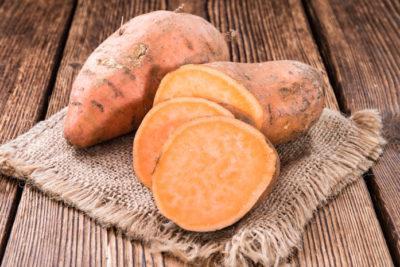

Unlike potatoes, sweet potatoes are not affected by the Colorado potato beetle.- The calorie content of sweet potatoes is 2-3 times higher than the calorie content of potatoes.
- Sweet potatoes contain six times more potassium than potatoes.
- Sweet potatoes have 4 times more carbohydrates than potatoes, which is why it tastes sweet.
- Sweet potatoes do not increase the glycemic index (relatively safe for diabetes mellitus), unlike potatoes, which are not recommended for food for this disease.
- The sweet potato belongs to the bindweed crops, the potato to the nightshade.
Learn more about the differences between sweet potatoes and potatoes here.
Cleaning and storing sweet potatoes


The sweet potato harvest begins 14-16 weeks after the seedlings are transplanted into open soil, usually in mid-September. Do not forget that the harvest must have time to be harvested before the onset of frost, and for this you should choose a fine and dry day. At this time, yellowing and drying of foliage and shoots should begin. If the tubers were dug out in damp weather, they cannot be stored, in this regard, they must be processed, the same must be done with injured root crops. To extract tubers from the soil, use a pitchfork, then they must be left on the surface of the site for a while so that they can dry well. It is necessary to dig them out of the soil very carefully, since their length can reach up to 0.3 m.When the roots dry out, the remains of the soil must be removed from their surface, and then they must be sorted. Healthy and whole tubers are suitable for storage, while all injured and in doubt must be sent for processing. Those root vegetables that are suitable for storage should be placed in a warm place for 7 days (from 28 to 30 degrees), while the air humidity should be 85-90 percent, do not forget to systematically ventilate the room. After that, the tubers are placed in not very deep trays and stored in a cool room (from 10 to 15 degrees), where they will be stored for several months.
Sweet potatoes can be stored frozen by cutting them into slices and then fried until half cooked. Then they are placed in containers or bags, then they are tightly closed and put into the freezer. Also, this root vegetable can be stored in a dried form, for this it is thoroughly washed, peeled and cut into strips or thin slices. They must be washed with running water and blanched in boiling water for five minutes, after which they are sharply cooled by immersion in water. When the water drains, the sweet potatoes are laid out on a baking sheet in 1 layer and placed for drying in an oven heated to 80 degrees, while it must be systematically stirred. When the roots are thoroughly dry, you need to wait until they cool completely naturally, then they are poured into bags or paper bags for storage.
Also tubers can be used for preservation. They are cut into cubes and boiled until half cooked in water, which needs to be salted and added spices, then they are laid out in sterilized jars with a volume of 0.5, boiling water is poured into them and half a teaspoon of vinegar is added to each, then they are rolled up and removed under a fur coat until it cools completely. Completely cooled cans are removed for storage.
Chemical composition: how is it useful?
Per 100 g of product:
- calorie content - 86 kcal;
- proteins - 1.5 g;
- fats - 0.5 g;
- carbohydrates - 25 g (of which starch - 13 g);
- dietary fiber - 3 g; water - 78 g.
Vitamins:
- vitamin A - 800 mcg;
- ascorbic acid - 2.5 mg;
- thiamine - 0.080 mg;
- riboflavin - 0.07 mg;
- pyridoxine - 0.3 mg;
- folic acid - 15 mcg;
- vitamin K - 2 mcg.
Trace elements:
- iron - 0.7 mg;
- magnesium - 32 mg;
- phosphorus - 48 mg;
- calcium - 32 mg;
- potassium - 337 mg;
- sodium - 55 mg;
- zinc - 0.3 mg;
- selenium - 0.6 mcg.
Types and varieties of sweet potatoes


The sweet potato does not have an official varietal classification; there are about 7 thousand total hybrids and varieties of such a plant. About 100 varieties of sweet potatoes are cultivated in China alone. All varieties are divided into vegetable, fodder and dessert. They are also distinguished by the color of the pulp, by the color of the peel and by the shape of the root crop. They also distinguish such characteristics as: the shape and color of the foliage, yield, as well as the accuracy of the formation of tubers. Still, all varieties are divided into early ripening, mid-ripening and late-ripening according to the ripening period.
Dessert sweet potato


These varieties contain large amounts of glucose and beta-carotene. The color of the pulp of the tubers is orange or rich yellow, and their taste is sweet. Such varieties are light-loving and thermophilic, in this regard, they grow rather poorly in mid-latitudes, the subtropics and tropics are best suited for them. The taste of the tubers depends on the variety and can be similar to pumpkin, banana, pineapple, chestnut or carrot. They go well with nuts, molasses, fruits and caramel, and therefore this sweet potato is most often used in the preparation of casseroles, sweet cereals and other desserts. The most popular varieties:
- Kumara Red... This hybrid is distinguished by its demanding temperature and illumination. Large bushes have thick leaves and long whips. The shape of the roots is oblong-rounded, the taste of the pale yellow pulp is moderately sweet. The raw pulp has a slight astringency.
- Beauregard... It is very easy to care for such a plant. The very tasty and sweet tubers contain a large amount of carotene and glucose. The bushes are compact, the roots grow smooth, copper-colored. The color of the pulp is orange.
- O.Henry... This is a variety of the American Boregrad variety, which is highly resistant to harmful insects and diseases. The color of the tubers is pale cream, the sweetish light yellow pulp has a dry consistency.
- Garnet... This mid-early variety of American selection has an average yield. The tubers are pale red, the sweet flesh has an orange color.
- Victory 100... This early-maturing variety with high yields grows well in mid-latitude conditions. The bush is compact, and the roots are even and smooth. The orange flesh has a moderately sweet taste similar to bananas and nuts, but these characteristics appear only after the tubers lie down a little after being removed from the soil, and at first they are tasteless.
- Georgia Red... Such a fruitful variety grows well in mid-latitudes. The compact bush is decorated with dark red foliage. The color of rounded root crops is copper-orange. Light pulp while raw has a taste very similar to potatoes, but after heat treatment it becomes soft and sweet.
- Burgundy... This early ripe American variety is resistant to fusarium. The dark red tubers have a very pleasant smell and are rich in sucrose. The color of the dark orange pulp does not change even after heat treatment.
Fodder yam


The composition of the tubers of these varieties contains a smaller amount of sugars compared to vegetable or dessert. These varieties can be an excellent substitute for potatoes. As a rule, the pulp of the tubers has a light color, after heat treatment it becomes soft. Such root vegetables can be fried. These varieties grow well both in southern regions and in mid-latitude conditions. The most popular varieties:
- White bouquet... This variety has a high yield. Powerful bushes have long lashes. The mass of large cream-colored root crops in some cases can reach from 3 to 4 kilograms. The white pulp has a taste similar to chestnut.
- Brazilian... Such a hybrid grows well in mid-latitudes, it is resistant to diseases and harmful insects, and has a high yield. Light-colored roots have white flesh with a mild taste.
Vegetable sweet potato


The composition of tubers of vegetable varieties contains less glucose compared to dessert ones, but it is more than in fodder varieties. In this regard, the root vegetables have a taste similar to frozen potato tubers. Their pulp is light in color with splashes of yellow, orange or pink. After heat treatment, it becomes soft, tender and juicy. However, in most varieties, root vegetables are not suitable for frying, since they are somewhat watery, but they make a very tasty puree from them. The most popular varieties:
- Purple... An early ripe variety with high yields and resistance to harmful insects and diseases. This sweet potato is superior to potatoes in nutritional and taste qualities. The powerful bush has dark green foliage and long lashes. The purple color of the roots remains even after heat treatment. The pulp is practically unsweetened and has a chestnut flavor.
- White sweet potato... The tubers of this variety have a texture and taste very similar to that of a potato. This sweet potato grows well in mid-latitudes and has a fairly high yield. The shape of light root crops is oblong, their flesh is white.
- Japanese... This variety is early maturing. In red root vegetables, the flesh has a pale cream color. Compared to varieties with an orange heart, the pulp is less sweet and drier. Such tubers can be a substitute for regular potatoes.
- BIT-1... This Italian variety is late. White roots have a slightly sweet pulp of the same color.
- Bonita... This early ripening variety is starchy and slightly sweet, it has a high yield and resistance to fusarium. The pinkish-cream tubers have white flesh with a cream shade.
- Bushbuck... The homeland of this sort is South Africa. The color of the tubers is raspberry pink, during storage it becomes darker. The slightly sweet, creamy white flesh tastes very similar to potatoes.
- Vinnytsia pink... This Ukrainian variety has a high yield. Bushes are tall. The color of smooth root crops is pink, they are distinguished by excellent keeping quality. Light, almost unsweetened pulp while raw has a taste similar to cabbage stalk. Such sweet potatoes on sale are sometimes found under the names Redgold, Gocha and Tekken, since in appearance it is very similar to these varieties.
- Sumor... Such an early ripe variety is distinguished by its yield and resistance to harmful insects and diseases. The color of the root vegetables is creamy, the pulp is light and unsweetened, its taste is identical to that of potatoes.
In addition to the varieties described, the following varieties are very popular among gardeners: Tynung, Hanna Gold, Har Bay, Betty, Burgundy, Belvo, Baker, Butterbach white, red and pink, White Delight, Virginia, Delaware purple, Golden Bell, Derby, Jersey yellow and orange, Ginseng red, Indian, Carver, etc.
Cultivation and yield
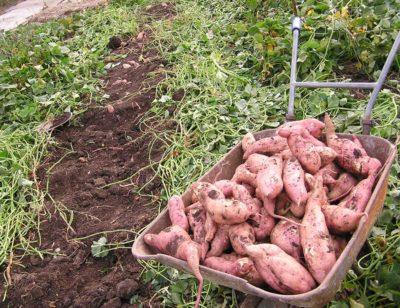

Planting of cuttings is carried out by a special planting machine, or manually at a distance of at least half a meter between the seedlings.- The distance between the rows should be at least 40-60 centimeters.
- Cuttings do not need to be rooted, rooting occurs naturally in 1-2 days.
- In the first 2 months of the growing season, the soil is kept moist. Loosening of the soil and removal of weeds is carried out at least once a week.
The total growth period is 90-150 days... The yield per hectare is 90-110 tons.
We suggest you watch a video about growing sweet potatoes:
Sweet potato properties: harm and benefit
Useful properties of sweet potato


The sweet potato tuber contains a fairly large amount of sugar and starch, but at the same time it is quite low in calories. They include proteins, carbohydrates, calcium, magnesium, potassium, phosphorus, iron, choline, thiamine, riboflavin, pantothenic acid, vitamins A, C, PP.
The starch of such a plant has found wide application in official medicine. So, it is used during the treatment of various diseases of the digestive tract, while it has a softening, fortifying and enveloping effect, it also contains a large amount of vitamins. Roots contain vitamin B6 (pyridoxine), which helps to strengthen the walls of blood vessels, which is why people suffering from cardiovascular diseases are advised to include sweet potato dishes in their diet.
Compared to other vegetables, sweet potatoes contain much more ascorbic acid, which protects the body from the effects of free radicals, which cause cellular corrosion that contributes to the development of cancer. This vegetable is recommended for women during menopause, as it contains progesterone. Since the fiber in tubers is much more tender than in other vegetables, it is recommended to include them in the diet for people who suffer from digestive disorders. Such root vegetables, fried and boiled, have a sweetish taste similar to frozen potatoes, but they contain much more carbohydrates and calcium than potato tubers.
Distribution and habitats
Morning glory sweet potato is a tropical plant. The homeland of its growth is Africa, tropical regions of South America, Southeast China. The spread and cultivation of morning glory as an ornamental plant is also possible in countries with subtropical or temperate climates. In our latitudes, the cultivation of morning glory is also successful, but exclusively as an annual plant.
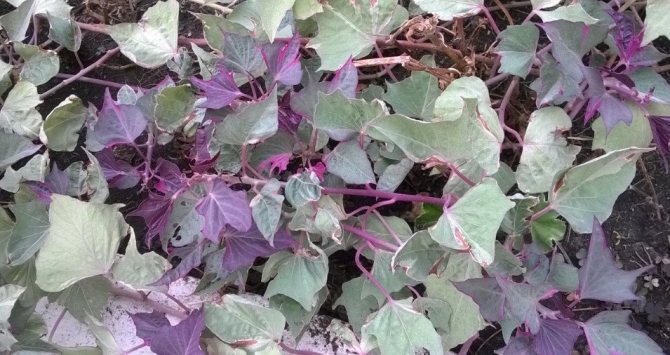

Important! Eating sweet potato tubers during pregnancy or breastfeeding is not recommended.
Plant propagation: methods
- From tubers. In the fall, they are dug up and placed in a cool place. When buds begin to appear (the beginning of winter), the tubers are placed in a container with soil. The shoots that grow back are separated along with the roots and planted. With proper care, up to 20 plants can be grown from 1 tuber.


Morning glory reproduces well by cuttings - Cuttings. This is the main breeding method for decorative morning glory. In February, cuttings are cut from the grown shoots. Each of them must have 2 internodes. Even without special care, the shoots take root in the water in 3-5 days. In wet soil, roots appear from internodes. These shoots are also used for propagation of decorative culture.
Advice. Ipomoea propagation by seeds and seedlings is possible.
Prevention of the appearance of various problems
- Compliance with the rules of crop rotation, planting sweet potato tubers in their original place no earlier than after 3 years.
- Keeping the soil moist.
- Support of daylight hours for sweet potatoes at least 8 hours (fluorescent lamps).
- Soil cultivation with wood ash, tobacco dust.
- Regular weeding and loosening of the soil.
- Weed removal.
- Compliance with the rules for storing tubers.
Site preparation
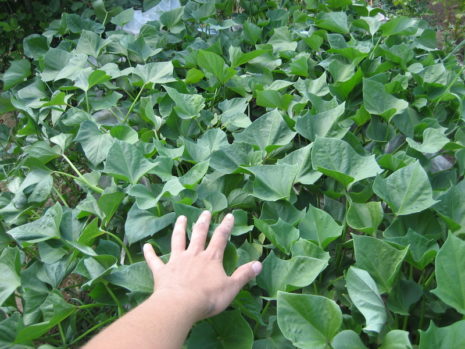

The plot should be well lit by the sun, on the south side. It will be good if the ridges from the north are covered with a hedge or some kind of small buildings. In this case, the plants will be provided with good heating.
The sweet potato cannot stand even a small shadow, and this must also be taken into account. The best soils for culture are loose, breathable. Root crops grow well on sandy and sandy soils, small loam.
ON A NOTE! They do not dig a bed under the sweet potato very deeply, making it possible for the plant to build up a powerful and strong root system.
A good harvest can only be obtained on well-fertilized nutrient soils. It is advisable to apply fertilizers in the fall:
- compost (4-5 kg);
- rotted manure (up to 3 kg);
- superphosphate (20 grams);
- potassium sulfate (12-15 grams).
All doses are given per square meter of the bed.
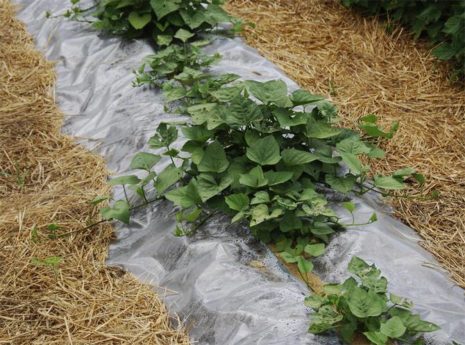

It is necessary that groundwater does not pass nearby, and if the soil is too acidic, then dolomite flour or fluff lime is added. Already in the spring, when preparing the site, the garden for the sweet potato is dug up again and the holes are prepared.
Water and feed regularly
| Watering Stages:
|
| Top dressing Stages:
|
| Pruning Stages:
|
Cooking recipes
This vegetable does not lose useful components during processing., therefore, the use of sweet potatoes is recommended not only raw, but also thermally processed: it can be baked, boiled, fried. They add root vegetables to the first and second courses, interfere with diet salads. Sweet potato goes well with lemon juice or orange peel, you can season it with hot peppers and curry.
Puree
To prepare this dish, root vegetables are peeled, cut into cubes, poured over with water and put on fire. Cook for no more than half an hour (you need to make the vegetable cubes soft).
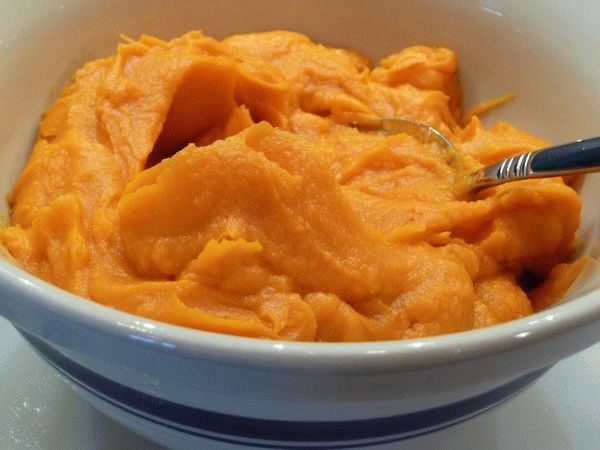

The water is drained, leaving a little, and the cooked sweet potato is kneaded with a fork or potato grinder. You can pour a little boiled milk into the puree.
During cooking, neither salt nor sugar is added: the finished dish turns out to be quite sweet.
Fried sweet potato
Cut the peeled vegetable into small slices and fry in vegetable oil, stirring regularly until tender. In this case, salt is also not added, because even without it, the dish turns out to be very tasty.


Agricultural technology of cultivation, 2 types of reproduction


Sweet potatoes are grown by cuttings. They take root quickly and well. I was sent rooted cuttings of different varieties of sweet potatoes in early July, when it was 40 degree heat. To be honest, I thought that they would not take root. I planted it on the garden bed that was freed after harvesting the garlic, watered it abundantly and covered it with buckets without a bottom for shading, and covered it with agrofibre on top.
To my surprise, after a few days all the cuttings were alive and well. I removed the agrofibre, and then gradually the buckets. Plants developed rapidly, conquering an ever larger area. There were no weeds, because the sweet potato covered the area allotted to it with a continuous carpet. Thus, the care consisted only in watering.
The vegetable is harvested after the first frost. Since the cuttings of sweet potatoes were planted late, I did not hope for any harvest. But the tubers grew quite large. They were enough for our family and friends to taste, as well as for seed. Photos of the sweet potato plant below.


To obtain cuttings, tubers are used, which are pre-germinated. Tubers germinate well in warmth and in the presence of light. They can be put in boxes, lightly sprinkled with earth and moistened. You can just put the tuber in a glass of water. Sprouted shoots are cuttings. Then they are cut, put in water for rooting, and the remaining tuber will give new ones. This process is just ahead of me.
The soil
In a specialty store for growing indoor morning glory, you can purchase standard soil for flower plants, or you can make a mixture yourself. To do this, neutral soil from the street must be disinfected in any way, then mixed with humus, adding superphosphate and potassium fertilizers.If ordinary soil is too acidic, then it is mixed with ash or lime. And after five days, fertilizers are added.
The main thing is that the soil is very lush. Although, if you do not bother with the composition of the soil, the sweet potato will still grow, but not as luxuriantly as we would like and without inflorescences. It is advisable to add potassium once a year, it is best to do this in August and early September. You can feed with ash, for this, a glass of ash is diluted in a ten-liter bucket of water. Mix well and water a little.
Morning glory nocturnal: an unusual species of bindweed relatives
Morning glory at night (Ipomoea noctiflora) also has other names: Ipomoea moonflower (moonflower), or morning glory... Usually, morning glories open with the first rays of the sun and fade at noon, for which they received the nickname "morning radiance". But the moon-flowering morning glory has a very original flowering routine. Its snow-white satin flowers open at dusk and bloom until morning.
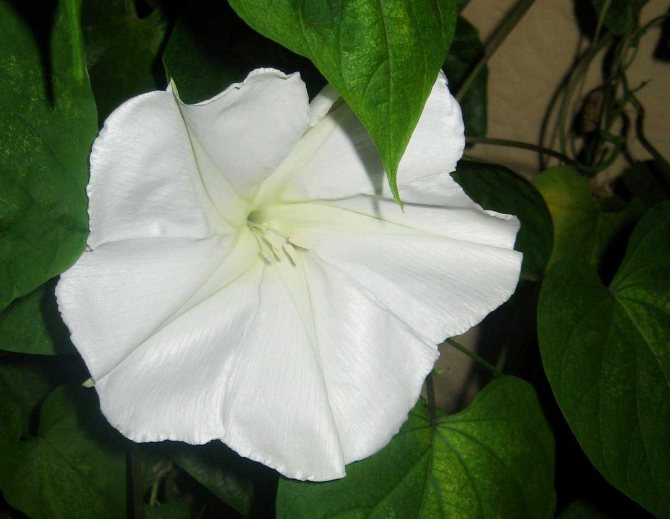

Morning glory (Ipomoea noctiflora).
This variety surprises with its huge flowers (up to 15 centimeters in diameter) and the unusual shape of the flowers that do not look like a gramophone, but a real pipe. The aroma of its flowers is very delicate and a little like almonds, but, unfortunately, it is felt only up close.
At dusk, the amazing flowers seem to glow like a small moon. With their appearance and smell, they attract many nocturnal insects, for example, hawk moths.
Note! On the Internet, information sometimes comes across that the flowers of the moon-flowering morning glory supposedly bloom abruptly with the onset of dusk, emitting a characteristic cotton. Once, out of curiosity, I spent the whole evening next to this morning glory, but I did not have to observe any sudden opening of the flower. The buds unfolded slowly and completely silently. Therefore, such statements are probably the fruit of someone's fantasy.
In terms of growth rate, the night morning glory is slightly ahead of the purple morning glory, its stems are thicker, and the foliage is larger. A leaf blade with less pubescence, while some leaves have the correct heart shape, while others have pointed projections (semi-lobed). The foliage of the bush is very high, so the night morning glory is perfect for landscaping gazebos.
It's easy to grow! ↑
Sweet potato pleases with its vitality. He is not afraid of droughts and diseases. He is not even afraid of the Colorado potato beetle, which is very different from his namesake - the potato. There is another important difference - it reproduces by cuttings, not tubers.
Cuttings can be germinated from tubers. Another option is to plant the stalk in a pot in the fall and grow a sweet potato bush at home. It will become a source of cuttings in the spring. Cuttings are green segments 15-20 cm long. They are immersed in water for several days until root shoots form, and then transferred to the ground to a permanent place.
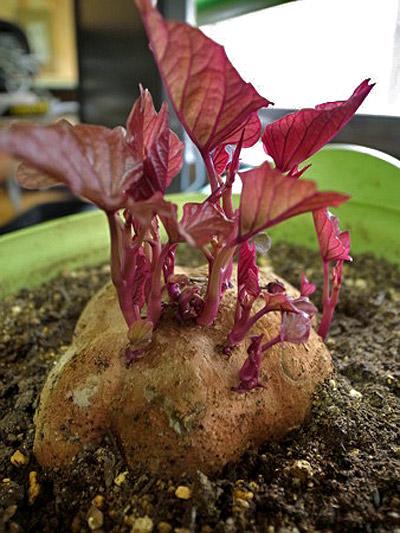

In my house, sweet potatoes are one of my favorites. It tastes more like pumpkin and carrots. But I haven't had to grow it myself - I still can't find a place to experiment with sweet potatoes. If you managed to grow decorative varieties of sweet potatoes, share your experience and photos. The people will be grateful to you!
Morning glory nile: one of the forgotten relatives of the bindweed
Have Ipomoea nillike its hybrid variety Imperial Ipomoea (Ipomoea imperialis), you can find the most amazing inflorescences in color and shape, and even varieties with unique variegated foliage.


Ipomoea nil.
In appearance, the natural variety is very similar to the traditional purple morning glory. It is a powerful liana up to three meters high, abundantly covered with heart-shaped foliage with slight pubescence, blooming with large funnel-shaped flowers up to 10 centimeters in diameter.
Like most species of morning glory, the flowers of the Nile morning glory live only one day and are open until noon. This plant was incredibly fond of the Japanese, thanks to which numerous improved varieties appeared in the Ipomoea Nile. It is often difficult to recognize the familiar "bindweed" in them.
Soup puree
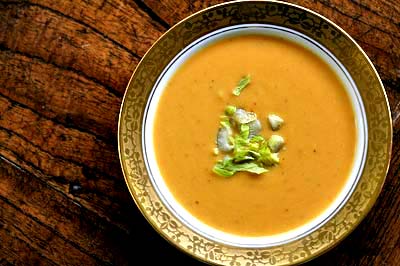

Soups are easy to prepare. Plus, they can be frozen for later use. Sweet potato is ideal for soup because it is very filling and goes well with other ingredients. You can add curry powder and a pinch of ground red pepper to make the soup taste more interesting. Experiment with different spices and flavors until you find one that suits you and your family better. Lentil Sweet Potato Soup Recipe
Diseases and pests
Sweet potatoes are susceptible to the following pests:
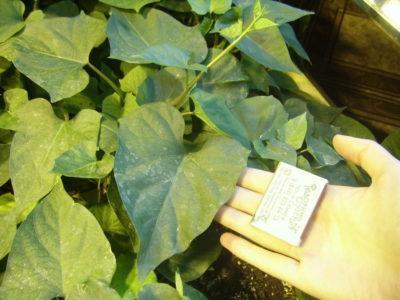

rodents;- bear;
- slugs;
- wireworms.
Disease manifestations: decay of foliage, tubers and roots, drying out of the plant.
Control measures:
- soil cultivation with wood ash, tobacco dust;
- collecting slugs by hand;
- installation of ultrasonic devices from rodents, planting buckwheat crops and tomatoes next to the sweet potato;
- filling the holes with buckwheat powder before planting.
Photo gallery


Vegetable kind of sweet potato variety Purple


Dessert sweet potato grade Pobeda 100


Fodder type of sweet potato variety Brazilian
Balcony varieties
There are more than 7000 varieties. They, in turn, are divided into three large groups:
Basically, they are all cultivated in the open field, but there are some varieties that suitable for growing at home or indoor conditions.
These include the following:
- Kumara Red - this plant variety is very demanding on light and heat. It is possible to grow it at home with an additional light source. The plant is large, has voluminous and lush leaves. Tubers are oval, yellow.
- Burgundy - refers to early varieties. It has large leaves and inflorescences with a pleasant aroma. Deep red fruits.
- Purple - Another early variety that lends itself to growing at home. It is resistant to diseases and pests. It has a powerful bush with dark green leaves.
Read also: How to make stuffed cabbage rolls from grape leaves

